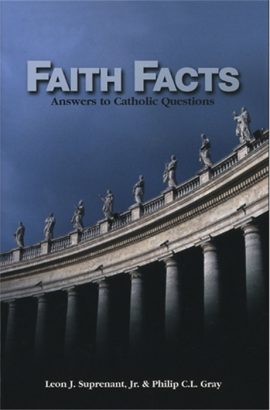By Leon J. Suprenant Jr. and Philip C.L. Gray
Together, Leon Supernant and Philip Gray are the authors of Faith Facts, a series of two books answering common questions on the Catholic faith.

The Catholic Church teaches that Sacred Scripture is truly the Word of God. Through the Bible, God gradually reveals Himself, communicates His plan of salvation, and calls us to a relationship with Him.
The Church has always taught that we can approach the Scriptures with a rock-solid confidence because they are inspired by God Himself and therefore contain no error. This inerrancy is a great gift because it gives the Bible a credibility on which we can base our lives. God inspired the Scriptures in order to give us a fully trustworthy source about what we are to believe and how we are to act. When read within the Church’s living Tradition and magisterial teaching, the Bible is a sure guide for our lives.
The basis for the Church’s teaching on biblical inerrancy is inspiration. Here we must remember that the Bible is different from any other book. It is unique because it has a unique author: God Himself. As Saint Paul says:
“All scripture is inspired by God and profitable for teaching, for reproof, for correction, and for training in righteousness, that the man of God may be complete, equipped for every good work (2 Tim 3:16-17).
Divine inspiration literally means “God-breathed.” This is why the Church teaches that the Scriptures “have God as their author.” God worked through human writers who “consigned to writing whatever he wanted written, and no more” (DV 11). So while the human writers made full use of their own powers and abilities, they were at the same time inspired by the Holy Spirit so that the words of Scripture are written exactly the way God Himself intended. Indeed, the Scriptures contain the very words of God expressed in the words of men (DV 13, 16).
Since the words of Scripture are inspired by God Himself, the Church has always taught that every part of the Bible is without error. Otherwise “error” in the Bible would have to be attributed to God, who is supreme Truth and who can neither deceive nor be deceived.
Pope Leo XIII, in his 1893 encyclical Providentissimus Deus (On the Study of Sacred Scripture), explained:
[S]o far is it from being possible that any error can co-exist with inspiration, that inspiration not only is essentially incompatible with error, but excludes and rejects it as absolutely and necessarily as it is impossible that God Himself, the supreme Truth, can utter that which is not true. This is the ancient and unchanging faith of the Church (no. 20, emphasis added).
Pope Pius XII reaffirmed the inerrancy of the Bible in his 1943 encyclical Divino Afflante Spiritu (On the Most Opportune Way to Promote Biblical Studies). He compared Scripture’s inerrancy to Christ’s sinlessness: “For as the substantial Word of God became like to men in all things, ‘except sin,’ so the words of God, expressed in human language, are made like to human speech in every respect, except error” (no. 37).
Vatican II and the Catechism of the Catholic Church likewise affirm that God’s inspiration of the Scriptures leaves no room for any error in the Bible:
Since, therefore, all that the inspired authors, or sacred writers, affirm should be regarded as affirmed by the Holy Spirit, we must acknowledge that the books of Scripture firmly, faithfully and without error, teach that truth which God, for the sake of our salvation, wished to see confided to the sacred Scriptures (DV 11; Catechism, no. 107, emphasis added, footnote omitted).
The Church teaches that the Bible is inerrant in all that the sacred writers intended to affirm. The Pontifical Biblical Commission’s 1993 document The Interpretation of the Bible in the Church makes the important distinction between the literal sense of Scripture and a literalistic interpretation. The literal sense is “that which has been expressed directly by the inspired authors.” To arrive at the literal sense, one must interpret the text according to the literary conventions of the time and consider the author’s intention, literary genre, and historical context. A literalistic reading disregards these considerations.
For example, when Christ warns that it is better for you to cut your hand off if it causes you to sin (Mark 9:43), He is using a literary metaphor. However, a literalistic reading would take this teaching of Christ at face value and wrongly encourage cutting off portions of the body that cause one to sin! Similarly, when Psalm 73:20 speaks of God awakening, this is not meant to teach that Yahweh actually sleeps at night and gets up in the morning, but rather this figurative language describes how God, after remaining seemingly unresponsive to a situation, begins to take action like a man awaking from sleep.
When it comes to matters of natural science, the Church teaches that the sacred authors did not necessarily intend to teach physics, astronomy, or chemistry. For example, when the Scriptures describe the sun as moving around the earth (Ps 19:4-6; Eccles 1:5), the sacred writer was not intending to give astronomy lessons. A literalistic approach would have to deny the modern scientific data showing that the earth revolves around the sun.
However, the writers were intending to report what appeared to their senses, and did so accurately. As Pope Leo XIII explained:
“[T]hey did not seek to penetrate the secrets of nature, but rather described and dealt with things in more or less figurative language, or in terms which were commonly used at the time. . . . Ordinary speech primarily and properly describes what comes under the senses; and somewhat in the same way the sacred writers . . . went by what sensibly appeared (PD 18).
We commonly speak this way. When the weatherman says the sun will rise tomorrow at 6 a.m., we do not accuse him of a great astronomical blunder. He is accurate in his statement because he is not intending to teach about the movement of the sun, but to tell us about what appears to our senses by using common, figurative language. Likewise, the biblical texts cited above that describe the sun’s movement around the earth are inerrant. The sacred writers reported without error what they intended to report—not natural science, but what really appeared to the senses.
These principles can be used for demonstrating the inerrancy of other biblical passages that are often accused of being erroneous in light of modern science.
You Might Also Like

Faith Facts: Answers to Catholic Questions, Volume I presents sound, constructive teaching on a variety of subjects important to Catholics today. This volume answers more than twenty questions related to key Catholic teachings such as the Real Presence in the Eucharist, papal authority, and more.

